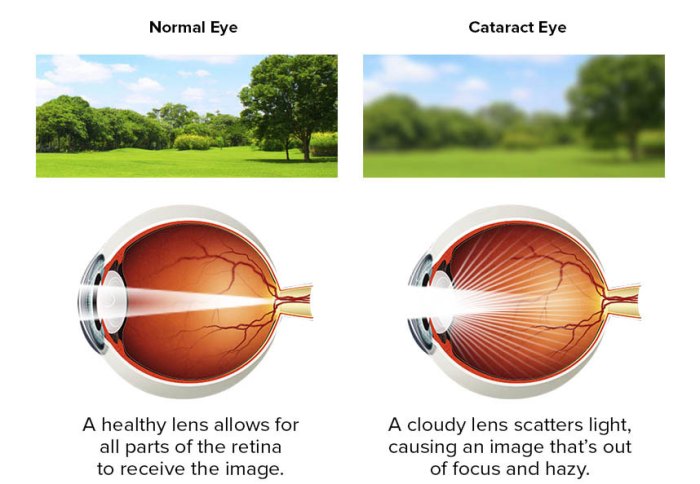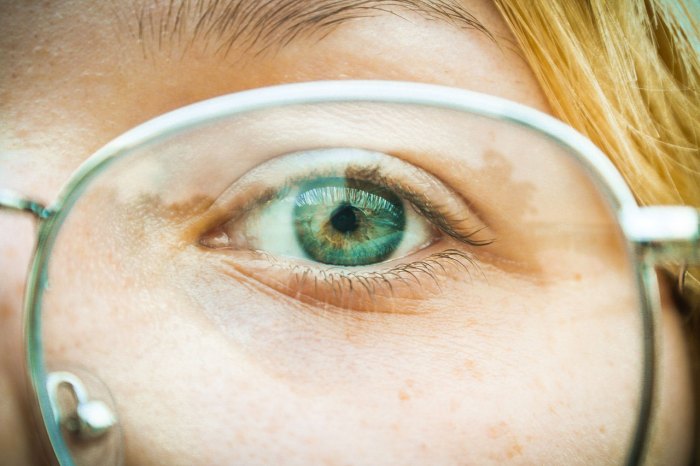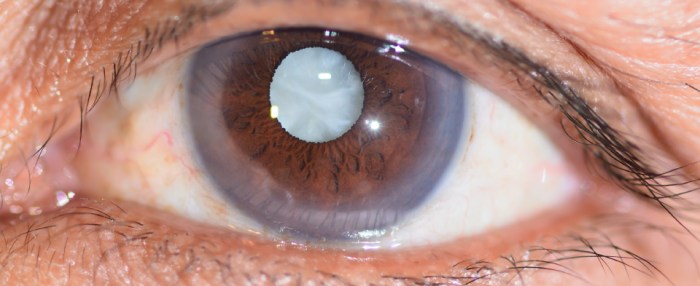Caleb has poor eyesight from cataracts, a common eye condition that can significantly impair vision. This narrative delves into the causes, symptoms, treatment options, and impact of cataracts, shedding light on Caleb’s journey towards restored vision.
Cataracts, a clouding of the eye’s lens, affect millions worldwide, leading to blurred vision, glare, and difficulty recognizing faces. Understanding the causes and types of cataracts is crucial for early detection and timely treatment.
Caleb’s Poor Eyesight: Cataract Formation

Cataracts are a clouding of the eye’s natural lens, which can lead to impaired vision. As we age, the proteins in the lens can clump together and form cataracts. Other risk factors include genetics, eye injuries, and certain medical conditions such as diabetes.
There are different types of cataracts, each affecting vision in unique ways. Nuclear cataracts form in the center of the lens, causing blurry vision. Cortical cataracts develop in the lens’s outer rim, creating wedge-like spokes that can impair peripheral vision.
Posterior subcapsular cataracts form at the back of the lens and can cause glare and difficulty seeing in bright light.
Cataracts can significantly impact daily activities. Reading becomes challenging due to blurred vision. Driving becomes hazardous as cataracts impair night vision and create glare from oncoming headlights. Recognizing faces and navigating unfamiliar environments can also become difficult.
Symptoms and Diagnosis of Cataracts

Common symptoms of cataracts include:
- Blurred or cloudy vision
- Glare and halos around lights
- Double vision
- Fading colors
- Difficulty seeing at night
- Frequent prescription changes
Cataracts are diagnosed through comprehensive eye exams. An ophthalmologist will examine the eyes using a slit lamp and perform a dilated eye exam to check for lens clarity and other eye abnormalities.
In some cases, imaging tests such as optical coherence tomography (OCT) may be used to provide detailed images of the lens and surrounding structures.
Treatment Options for Cataracts
The primary treatment for cataracts is surgical removal. During cataract surgery, the clouded lens is replaced with an artificial intraocular lens (IOL).
Cataract surgery is typically performed on an outpatient basis using local anesthesia. The surgeon makes a small incision in the eye and uses lasers to break up the cataract. The fragmented cataract is then removed using suction or irrigation.
There are different types of IOLs available, each with its advantages and disadvantages. Monofocal IOLs provide clear vision at one specific distance, while multifocal IOLs offer a wider range of vision.
Recovery from cataract surgery is typically quick, with most patients experiencing improved vision within a few days. Risks and complications of cataract surgery are rare but may include infection, inflammation, and retinal detachment.
Caleb’s Vision Restoration and Impact: Caleb Has Poor Eyesight From Cataracts

After cataract surgery, Caleb’s vision improved significantly. He could now read without straining, drive safely at night, and recognize faces with ease.
The restored vision had a profound impact on his daily life. He regained his independence, was able to pursue hobbies he had given up, and enjoyed social interactions with newfound confidence.
Caleb’s experience highlights the benefits of cataract treatment in improving vision and overall quality of life.
Cataract Prevention and Management

While cataracts are a common part of aging, there are steps that can be taken to prevent or delay their formation:
- Wear sunglasses to protect the eyes from UV radiation
- Manage underlying health conditions such as diabetes
- Quit smoking
- Eat a healthy diet rich in fruits, vegetables, and antioxidants
- Exercise regularly
Regular eye exams are crucial for early detection and timely treatment of cataracts. If you notice any changes in your vision, consult an ophthalmologist promptly.
FAQ Overview
What are the main causes of cataracts?
Aging, genetics, eye injuries, and prolonged exposure to UV radiation are common causes of cataracts.
How can I prevent cataracts?
Wearing sunglasses, protecting eyes from UV radiation, and managing underlying health conditions can help prevent or delay the development of cataracts.
What are the symptoms of cataracts?
Blurred vision, glare, double vision, difficulty seeing at night, and faded colors are common symptoms of cataracts.
How are cataracts diagnosed?
Cataracts are diagnosed through comprehensive eye exams, including visual acuity tests, slit-lamp examinations, and imaging techniques.
What are the treatment options for cataracts?
Cataract surgery is the primary treatment option, involving the removal of the clouded lens and implantation of an intraocular lens.